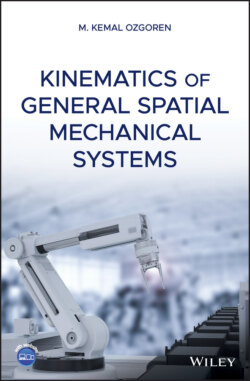Читать книгу Kinematics of General Spatial Mechanical Systems - M. Kemal Ozgoren - Страница 77
3.9.4 Homogeneous Coordinate Transformation Between Two Reference Frames
ОглавлениеReferring to Eqs. (3.184) and (3.185), it is seen that the result of a combination of several affine transformations necessitates carrying out a considerable number of addition and multiplication operations involving 3 × 1 and 3 × 3 matrices. However, a large number of matrix operations is not desirable of course especially from the viewpoint of computational efficiency.
On the other hand, if the transformations are expressed homogeneously, the number of necessary matrix operations reduces considerably to such an extent that only a minimal number of multiplications are required without any additions. However, this reduction in the number of operations necessitates the introduction of 4 × 1 and 4 × 4 augmented matrices in return. Even so, the advantage of the reduction in the number of operations emphatically overcomes the disadvantage of the increased dimension of the matrices.
The affine transformation expressed by Eq. (3.175) can be converted into a homogeneous transformation as explained below.
Equation (3.175) can be combined with the trivial equation 1 = 1 in order to set up the following system of equations.
(3.186)
The preceding system of equations can be written as the following single matrix equation.
(3.187)
Equation (3.187) suggests the following definitions.
is defined as the augmented position matrix of P in . It is a 4 × 1 matrix formed as
(3.188)
is defined as the augmented position matrix of P in . It is a 4 × 1 matrix formed as
(3.189)
is defined as the homogeneous transformation matrix (HTM) between and . It is a 4 × 4 matrix formed as
(3.190)
Note that the HTM defined above has three major partitions. Its invariant trivial partition is its last row, which is . Its rotational partition is the 3 × 3 matrix and its translational partition is the 3 × 1 matrix .
By using the preceding definitions, Eq. (3.187) can be written in the following compact and linear form, which is known as the homogeneous transformation equation.
(3.191)
If there are several different reference frames such as , , , …, , then the following successive homogeneous transformation equations can be written.
(3.192)
As for the overall homogeneous transformation equation, it can be written as
(3.193)
Upon successive substitutions, the preceding equations lead to the following equation for the combined HTM.
(3.194)
As noticed above, the expression of the overall HTM given by Eq. (3.194) involves only matrix multiplications and thus it is much more compact and easier to compute as compared with the accumulation of the consecutive expressions given by Eqs. (3.184) and (3.185) for the rotation matrix and the bias term of the overall affine transformation expressed by Eq. 3.180.
